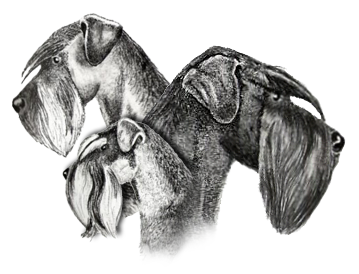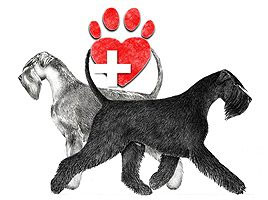Health Tests
As a minimum, the sire and dam of a litter should be screened for the following before breeding:
Health Screening Good Practice (Minimum)
1. Hip Scoring
2. Elbow Grading
3. prcd-PRA DNA Test
4. Genetic Diversity
Health Screening Best Practice (All the above including:)
5. Annual Eye Testing sire & dam
6. DCM DNA Test
7. HUU DNA Test
8. PRA5 DNA Test
9. Litter screening of puppies eyes for MRD and any other congenital conditions.
Health Article
Kennel Club Gazette health article Oct 2022
October 2022 | Kennel Gazette
Giant health matters
BY LESLEY PARKER, BREED HEALTH COORDINATOR
Giant Schnauzers are generally tough and hardy and tend
to just get on with whatever comes their way.
Most Giants live a healthy life with little reason to visit a vet, and so appearing ill can often be a sign of something significant. Life expectancy is between 10 and 12 years, although some have lived up to 16 years.
They are keen and alert, and eye health is important for their function as a guarding breed. The requirement for annual eye testing is mainly for hereditary cataracts. However, it can also detect other conditions such as progressive retinal atrophy (PRA). Luckily, there are DNA tests for two types of PRA: prcd-PRA and PRA5, both now recommended under the Assured Breeders scheme. Litter screening puppies for congenital eye defects is
also recommended, mainly for multifocal retinal dysplasia (MRD). While retinal folds may disappear in adulthood, the mutation may still be passed on to offspring. A few cases of persistent hyperplastic primary vitreous (PHPV) have also been noted, which may have more of an impact on vision, demonstrating the importance of litter
screening before leaving the breeder. There is a recommendation to DNA test for dilated cardiomyopathy (DCM), a heart condition diagnosed in a litter of pepper/salts. Research carried out by the University of Missouri discovered a mutation already found in Standard Schnauzers (RBM20).
Good hips and healthy joints are central to the energetic and agile nature of the Giant Schnauzer, otherwise resting a lame Giant can be challenging. The uptake of hip and elbow scoring is increasing – ideally, hips should be below or around the median, currently 10. Elbows are usually 0, although a few grade 1 have been reported. It is important for growing puppies to receive an appropriate diet, with attention also to the amount and type of exercise to allow joints to develop normally. Boisterous puppies often need encouragement to rest. The age of neutering also requires consideration, ensuring joints develop under the control of necessary hormones, especially since growth plates may
not fully close until 18 months.
Epilepsy is being monitored and noted to occur historically within the breed – it is estimated around 4% of the UK population may be living with epilepsy. A recent breed study showed the mode of inheritance to be complex. Since there are no current health tests available, breeders are encouraged to pay attention to any occurrences in pedigrees (especially immediate relatives), avoid repeat matings, and select breeding mates with minimal risk.
Giant Schnauzers have an increased risk of developing toe cancer, mostly squamous cell carcinoma, thought to be linked with dark pigmentation and also melanoma. The majority of Giants never develop toe cancer. However, any ongoing nail issue requires prompt investigation. Symmetrical lupoid onychodystrophy (SLO) is a different condition affecting multiple nails, causing nails to break easily and fall out. It is often painful and requires lifelong treatment.
Around 3% are reported as affected with hypothyroidism, resulting from decreased production of thyroid hormones. A lethargic Giant is unusual, especially coupled with a thin coat and/or weight gain. Once diagnosed, hypothyroidism is treated with ongoing thyroxine medication. It is possible to determine the thyroid function of breeding dogs before mating.
The three breed clubs – Giant Schnauzer Club, Northern Schnauzer Club and Schnauzer Club of Great Britain – work together on an ongoing joint Schnauzer health survey facilitating the monitoring of health, along with a specific health fund. Our Breed Health and Conservation Plan, formulated with The Kennel Club, is in place. Up-to-date health information can be found on the health website giantschnauzerhealth.org.uk
Health Website
Up to date breed health information and latest news, can be found on the Giant Schnauzer Health website:
www.giantschnauzerhealth.org.uk
Health Survey
 If you own a Schnauzer of any size Miniature/Schnauzer/Giant, please take part in the Joint Schnauzer Breed Health Survey. Whether your Schnauzer is completely healthy, has any ongoing health issues, or deceased within the last 10 years.
If you own a Schnauzer of any size Miniature/Schnauzer/Giant, please take part in the Joint Schnauzer Breed Health Survey. Whether your Schnauzer is completely healthy, has any ongoing health issues, or deceased within the last 10 years.
www.schnauzerhealthsurvey.org.uk


